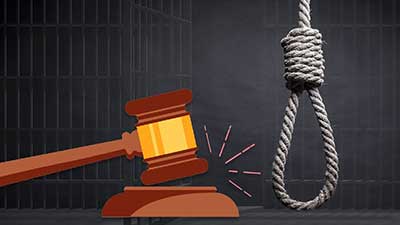Date: 24/03/2023
Relevance: GS-2: Structure, Organization, and Functioning of the Judiciary
Key Phrases: More Humane Mode of Execution, Death Penalty, Bachan Singh vs State of Punjab (1980), 35th Report of the Law Commission (1967), Deena Dayal vs Union of India and Others (1983), Section 354(5) of the CrPC, gas chamber, lethal injection.
Why in News?
- The issue of the death penalty and its mode of execution has been a subject of debate in India for a long time.
- Recently, the Supreme Court of India has taken a significant step towards finding a more humane method to carry out death sentences.
The Need for a More Humane Mode of Execution
- Forty years ago, the Supreme Court of India held that the mode of executing prisoners by hanging could not be considered too cruel or barbaric.
- However, the Court has now sought to find a more dignified and less painful method of execution.
- The idea of finding an alternative mode of execution, one that is less cruel and painful, has been a part of the wider debate on whether the death penalty should be abolished.
- The Court has asked for fresh data to substantiate the argument that a more humane means of execution can be found.
The Leading Judgments on Death Penalty and Mode of Execution:
- There are two leading judgments on the issue of the death penalty and its mode of execution.
- Bachan Singh vs State of Punjab (1980) upheld the death penalty but limited it to the ‘rarest of rare cases’.
- Deena Dayal vs Union of India and Others (1983) upheld the method of hanging by ruling that it is “as painless as possible” and “causes no greater pain than any other known method”.
Law commission’s recommendations:
- 35th Report of the Law Commission (1967) noted that while electrocution, the use of a gas chamber, and lethal injection were considered by some to be less painful, it refrained from recommending any change.
- In its 187th report in 2003, the Law Commission of India recommended that Section 354(5) of the CrPC should be amended by providing an alternative mode of execution of the death sentence by “lethal injection until the accused is dead”.
- Section 354(5) of the Code Of Criminal Procedure, 1973: When any person is sentenced to death, the sentence shall direct that he be hanged by the neck till he is dead.
The Supreme Court’s Approach towards Death Penalty:
- Even though the Supreme Court has not favoured abolition, it has developed a robust and humane jurisprudence that has made it difficult for the executive to carry out death sentences.
- It has restricted its use to the ‘rarest of rare cases’, mandated a balancing of aggravating and mitigating circumstances before sending someone to the gallows, and allowed a post-appeal review hearing in open court.
- At the same time, the Court has evolved a clemency jurisprudence that makes decisions on mercy petitions justiciable and penalizes undue delay in disposing of mercy pleas by commuting death sentences to life.
Centre’s stand:
- The Union government contends that hanging should be retained as the mode of execution, not only because it is not cruel or inhuman, but also because it accounts for the least number of botched-up executions.
Deepening Moral dilemma:
- Any form of execution is a fall from humaneness, offends human dignity, and perpetrates cruelty.
- Debating the mode of execution-only deepens the moral dilemma of whether the taking of life is the best response to the taking of life.
What is the practice in other countries?
- According to Amnesty International, 55 countries around the world have the death sentence on the books.
- While death by hanging is still the most prevalent form of execution, especially in the former British colonies, other modes are followed in some countries.
- United States: An intravenous lethal injection is given in every state (27 states and American Samoa) that allows the death penalty. Electrocution is a secondary method in some states.
- China: Execution by firing squad is employed
- Saudi Arabia uses beheading apart from other methods.
- India: The Air Force Act, 1950, The Army Act 1950, and The Navy Act 1957 say that execution has to be carried out either by hanging by the neck until death or by being shot to death.
Abolition is the Answer:
- If the aim is to eliminate cruelty and indignity, then abolition of the death penalty is the answer.
- Empirical evidence suggests that hanging need not result in early or painful death, while there is a body of proof that shows electrocution and lethal injection have their own forms of cruelty.
- The Supreme Court’s move towards finding a more humane method of execution is a step in the right direction.
- However, it is time for India to join the global trend toward the abolition of the death penalty.
Conclusion:
- The issue of the death penalty and its mode of execution is a complex one that requires a nuanced approach.
- While the Supreme Court has taken a significant step towards finding a more humane method of execution, the real issue is the morality of the death penalty itself.
- If the aim is to eliminate cruelty and indignity, then abolition is the only way forward.
- It is time for India to join the global trend toward the abolition of the death penalty and uphold it.
Source: The Hindu
Mains Question:
Q. Compare and contrast the different modes of execution used in India and other countries, and argue whether abolition is the only way forward to eliminate cruelty and indignity associated with the death penalty.







